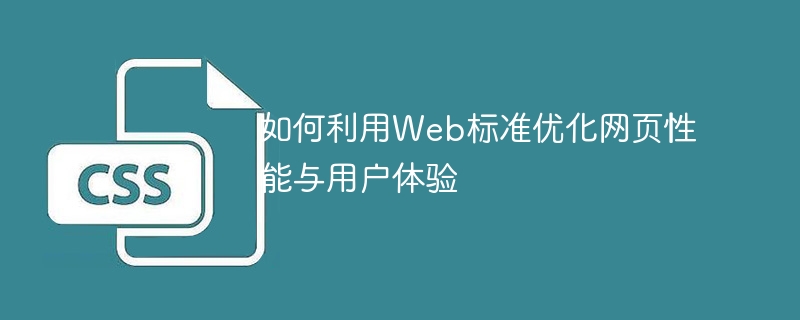

With the rapid development of the Internet, more and more companies and individuals are beginning to pay attention to the performance and user experience of web pages. On the one hand, good web page performance can improve website accessibility and search engine rankings; on the other hand, excellent user experience can increase user stickiness and conversion rate. Using web standards to optimize web page performance and user experience has become a mainstream method today.
So, how to use web standards to optimize web page performance and user experience?
First of all, make reasonable use of HTML tags and CSS styles. HTML is the basic language of web pages. Proper use of HTML tags can make the structure of web pages clearer and facilitate search engines to understand and index web content. At the same time, CSS styles can be used to beautify and layout web pages and improve the user's visual experience. For example, using semantic HTML tags can make the content of web pages more meaningful and facilitate search engine crawling and analysis. At the same time, using appropriate CSS styles can make web pages load faster and adapt to different screen sizes and devices.
Secondly, use JavaScript appropriately. JavaScript is a powerful scripting language that can add interactivity and dynamic effects to web pages. However, too much JavaScript code will increase the loading time of the web page and may cause compatibility and security issues. Therefore, reasonable use of JavaScript code is the key to optimizing web page performance and user experience. You can reduce the number of HTTP requests by compressing and merging JavaScript code. In addition, you can use JavaScript's asynchronous loading technology to delay loading of unnecessary code and reduce the first loading time of the web page. In addition, for some simple dynamic effects, you can consider using CSS animations instead of JavaScript implementations to reduce code dependencies and complexity.
Again, optimize network requests. Network requests are an important factor in web page loading time. Optimizing network requests can significantly improve web page performance and user experience. You can reduce the number of HTTP requests by merging and compressing CSS and JavaScript files. In addition, using a CDN (content distribution network) can speed up access to static resources and improve the loading speed of web pages. In addition, by using browser cache and HTTP cache control technology, repeated requests are reduced and the response speed of web pages is improved. You can also reduce the first loading time of web pages by using techniques such as lazy loading of images and lazy loading.
Finally, perform performance testing and optimization. For web page performance issues, you can use various performance testing tools for analysis and optimization. You can use the browser's developer tools to check the loading time and resource usage of the web page. You can use performance analysis tools to conduct detailed analysis and optimization of web page performance. At the same time, you can use performance testing tools to perform stress testing on web pages, simulate multiple users accessing web pages at the same time, and identify performance bottlenecks and optimize them.
To sum up, using web standards to optimize web page performance and user experience requires consideration from many aspects. By rationally utilizing HTML tags and CSS styles, rationally using JavaScript, optimizing network requests, and conducting performance testing and optimization, the performance and user experience of web pages can be improved and provide users with a better online experience. As a developer or website administrator, you should pay attention to the use and optimization of Web standards, constantly improve the quality and functionality of web pages, and meet the challenges of the Internet era.
The above is the detailed content of Methods to improve web page performance and user experience by using web standards. For more information, please follow other related articles on the PHP Chinese website!




